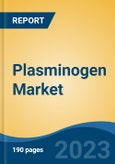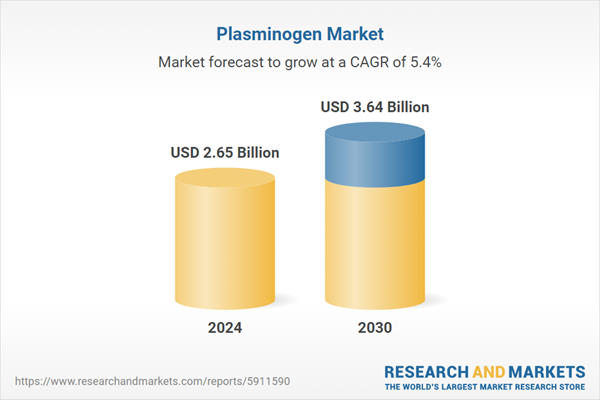Speak directly to the analyst to clarify any post sales queries you may have.
10% Free customizationThis report comes with 10% free customization, enabling you to add data that meets your specific business needs.
Key factors contributing to the rapid growth of the plasminogen market include the rise of personalized medicine and the expansion of healthcare infrastructure in emerging economies. As healthcare evolves, there is a greater focus on individualized treatment plans, which is anticipated to increase the adoption of plasminogen therapies. Additionally, investments in healthcare, especially in regions such as Asia-Pacific and Latin America, are driving market growth. The global rise in surgical procedures and the subsequent need for post-operative care have increased the demand for plasminogen therapies, particularly in wound care and tissue regeneration. Moreover, promising results in clinical trials have attracted investor interest, fueling continued innovation and the development of plasminogen-based products.
However, the plasminogen market faces several challenges that may impede its growth trajectory. One major obstacle is the high cost of manufacturing plasminogen-based therapies, which could limit their accessibility, particularly in low-income countries. Regulatory challenges, including rigorous approval processes for new plasminogen treatments, also present barriers for companies seeking to introduce innovative solutions. Despite these challenges, ongoing clinical advancements and the growing demand for effective wound healing solutions provide substantial growth opportunities for key market players. Efforts to reduce treatment costs and streamline the approval process are expected to address these challenges and further enhance the market’s potential.
Key Market Drivers:
Rising Prevalence of Clot-Related Disorders
The increasing prevalence of clot-related disorders is a significant driver of the global plasminogen market. Conditions such as venous thromboembolism (VTE), deep vein thrombosis (DVT), and pulmonary embolism (PE) have become more common due to factors such as sedentary lifestyles, rising obesity rates, and an aging population. In India, the incidence of DVT is reported to be 1% among adults over 40, with 15% to 20% of hospitalized patients affected. These disorders, which result from the abnormal formation of blood clots, can lead to serious complications like stroke, heart attacks, and respiratory failure, making timely treatment essential.Plasminogen plays a key role in preventing or resolving clot-related complications. A deficiency or dysfunction of plasminogen can impede the body’s ability to dissolve clots, increasing the risk of thrombotic events. As these disorders become more prevalent, the demand for plasminogen-based therapies to manage these life-threatening conditions is rising. Treatments involving plasminogen help dissolve existing clots and prevent new ones, improving patient outcomes and reducing complications. The growing number of diagnoses, coupled with improved diagnostic techniques and greater awareness, has expanded the patient base seeking effective treatment. This has led pharmaceutical companies to invest significantly in developing innovative plasminogen therapies, including recombinant plasminogen products, to address the growing demand for safe and effective clot management solutions.
Key Market Challenges:
High Treatment Costs
The high treatment costs associated with plasminogen-based therapies present a significant challenge to ensuring equitable access. The complex production of recombinant plasminogen products contributes to their elevated prices. The biotechnology processes involved in synthesizing plasminogen require sophisticated equipment, specialized expertise, and stringent quality control measures. Research, development, and manufacturing costs are substantial, and these expenses are often passed on to patients and healthcare systems.Additionally, regulatory requirements add to the overall cost. Companies must invest significantly in preclinical and clinical trials to demonstrate the safety and efficacy of plasminogen treatments, meeting the rigorous standards set by regulatory agencies such as the FDA and EMA. These trials involve extensive data collection and monitoring, further contributing to the cost.
The limited patient pool also drives up treatment costs. While clot-related disorders are prevalent, they do not affect as large a population as other medical conditions, preventing the economies of scale that could reduce production costs for plasminogen therapies.
Key Market Trends:
Regulatory Support and Clinical Trials
Regulatory support and clinical trials are crucial drivers for the growth of the global plasminogen market. Regulatory agencies such as the FDA and EMA play an essential role in ensuring the safety and efficacy of plasminogen-based therapies, providing the necessary frameworks for drug approval and market entry. In India, the Central Drugs Standard Control Organization (CDSCO) has expedited the approval of critical therapies, including novel plasminogen replacement treatments for congenital plasminogen deficiency.Clinical trials form the foundation for the development of plasminogen therapies, providing the evidence needed to validate their safety and effectiveness. As the number of clinical trials increases, so does the confidence in plasminogen’s potential, both among healthcare providers and regulatory agencies. In 2024, the Clinical Trials Registry - India (CTRI) reported a 15% increase in registered clinical trials for plasminogen therapies. Notably, a Phase III trial aimed at evaluating recombinant plasminogen for chronic venous leg ulcers is underway, further demonstrating the commitment to advancing plasminogen-based therapies.
The support from regulatory bodies like the FDA, EMA, and CDSCO is instrumental in expediting the approval process and ensuring the continued development and accessibility of plasminogen therapies, ultimately improving patient outcomes.
Key Market Players:
- Boehringer Ingelheim Inc. GmbH
- Kedrion S.p.A
- Genentech
- Prometic Life Sciences Inc.
- Grifols, S.A.
- Octapharma AG
- Green Cross Corporation
- Baxter International Inc.
- CSL Behring LLC
- Renaissance Acquisition Holdings LLC
Report Scope:
The report segments the global plasminogen market as follows:
By Type:
- Intravenous Injection
- Eye Drops
By Application:
- Ligneous Conjunctivitis
- Diabetic Foot
- Wound Healing
- Others
By Region:
- North America (United States, Canada, Mexico)
- Europe (France, United Kingdom, Italy, Germany, Spain)
- Asia-Pacific (China, India, Japan, Australia, South Korea)
- South America (Brazil, Argentina, Colombia)
- Middle East & Africa (South Africa, Saudi Arabia, UAE)
Competitive Landscape
The report provides a detailed analysis of key players in the global plasminogen market. Customizations are available to tailor the report to specific company needs, including additional profiling of up to five market players.This product will be delivered within 1-3 business days.
Table of Contents
Companies Mentioned
- Boehringer Ingelheim Inc. GmbH
- Kedrion S.p.A
- Genentech
- Prometic Life Sciences Inc
- Grifols, S.A
- Octapharma AG
- Green Cross Corporation
- Baxter International Inc.
- CSL Behring LLC
- Renaissance Acquisition Holdings LLC
Table Information
| Report Attribute | Details |
|---|---|
| No. of Pages | 182 |
| Published | February 2025 |
| Forecast Period | 2024 - 2030 |
| Estimated Market Value ( USD | $ 2.65 Billion |
| Forecasted Market Value ( USD | $ 3.64 Billion |
| Compound Annual Growth Rate | 5.4% |
| Regions Covered | Global |
| No. of Companies Mentioned | 10 |









